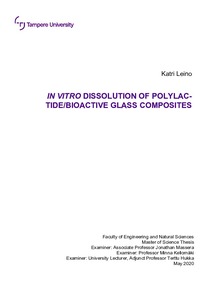In Vitro Dissolution of Polylactide/Bioactive Glass Composites
Leino, Katri (2020)
Leino, Katri
2020
Materiaalitekniikan DI-tutkinto-ohjelma - Degree Programme in Materials Engineering, MSc (Tech)
Tekniikan ja luonnontieteiden tiedekunta - Faculty of Engineering and Natural Sciences
This publication is copyrighted. You may download, display and print it for Your own personal use. Commercial use is prohibited.
Hyväksymispäivämäärä
2020-05-12
Julkaisun pysyvä osoite on
https://urn.fi/URN:NBN:fi:tuni-202005044898
https://urn.fi/URN:NBN:fi:tuni-202005044898
Tiivistelmä
Composite structures are an interesting area of study in the field of biomedical engineering. It is possible to customize the chemical properties of a bioactive glass and consequently the rate of both degradation and bonding to tissue. Whereas biocompatible polymers such as polylactide (PLA) are biodegradable, they do not bond with tissue as bioactive glasses do, but they do tend to have superior mechanical properties compared to glasses. Thus, by combining these two materials it is possible to create bioactive composites with tailored chemical properties and degradation rates that can be used in load-bearing tissue engineering applications.
The aim of this thesis was to investigate how bioactive glasses release ions through polymer matrix in composite structure and how different bioactive glasses react with the polymer matrix, changing the properties of the composite. The dissolution of pure PLA and six PLA/bioactive glass composites were studied during 10 weeks of in vitro hydrolysis in TRIS buffer at 37 °C. The composite rods were manufactured using either modified silicate glass 13-93 (10, 30, or 50 percentage by weight) or phosphate glass Sr50 (10, 25, or 35 percentage by weight). During the hydrolysis pH, mass loss, water absorption, ion release, glass content, and mechanical properties were studied.
During 10 weeks of hydrolysis, no substantial changes in pH, mass or mechanical properties of the pure PLA were observed. Composites with the lowest glass content (10%) showed little difference compared with the pure PLA, however an increase in the glass content induced changes in solution pH, sample mass and water uptake. It was shown that the glass particles dissolve through the polymer matrix. As expected, the phosphate glass dissolved faster than the silicate glass and composites degraded faster than pure PLA. Enhanced degradation rate of the composites was manifested by higher weight loss and decrease in mechanical properties. The results also indicate that the higher the glass content in the composite, the more the mechanical properties of the composite decrease and the faster the glass dissolves. The degradation of PLA/bioactive glass composites is greatly dependent on the type of glass used as filler and the amount of glass used.
The aim of this thesis was to investigate how bioactive glasses release ions through polymer matrix in composite structure and how different bioactive glasses react with the polymer matrix, changing the properties of the composite. The dissolution of pure PLA and six PLA/bioactive glass composites were studied during 10 weeks of in vitro hydrolysis in TRIS buffer at 37 °C. The composite rods were manufactured using either modified silicate glass 13-93 (10, 30, or 50 percentage by weight) or phosphate glass Sr50 (10, 25, or 35 percentage by weight). During the hydrolysis pH, mass loss, water absorption, ion release, glass content, and mechanical properties were studied.
During 10 weeks of hydrolysis, no substantial changes in pH, mass or mechanical properties of the pure PLA were observed. Composites with the lowest glass content (10%) showed little difference compared with the pure PLA, however an increase in the glass content induced changes in solution pH, sample mass and water uptake. It was shown that the glass particles dissolve through the polymer matrix. As expected, the phosphate glass dissolved faster than the silicate glass and composites degraded faster than pure PLA. Enhanced degradation rate of the composites was manifested by higher weight loss and decrease in mechanical properties. The results also indicate that the higher the glass content in the composite, the more the mechanical properties of the composite decrease and the faster the glass dissolves. The degradation of PLA/bioactive glass composites is greatly dependent on the type of glass used as filler and the amount of glass used.
